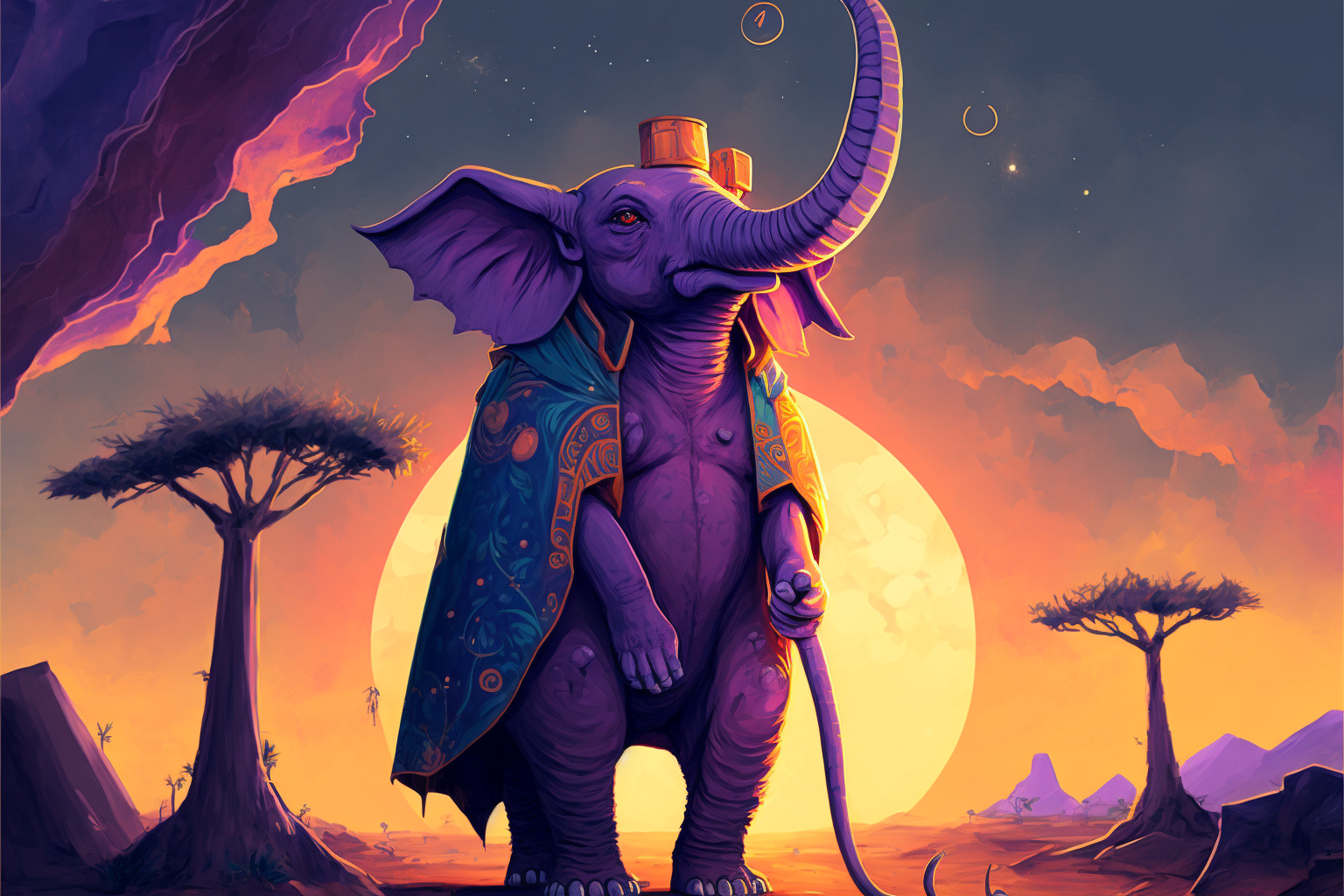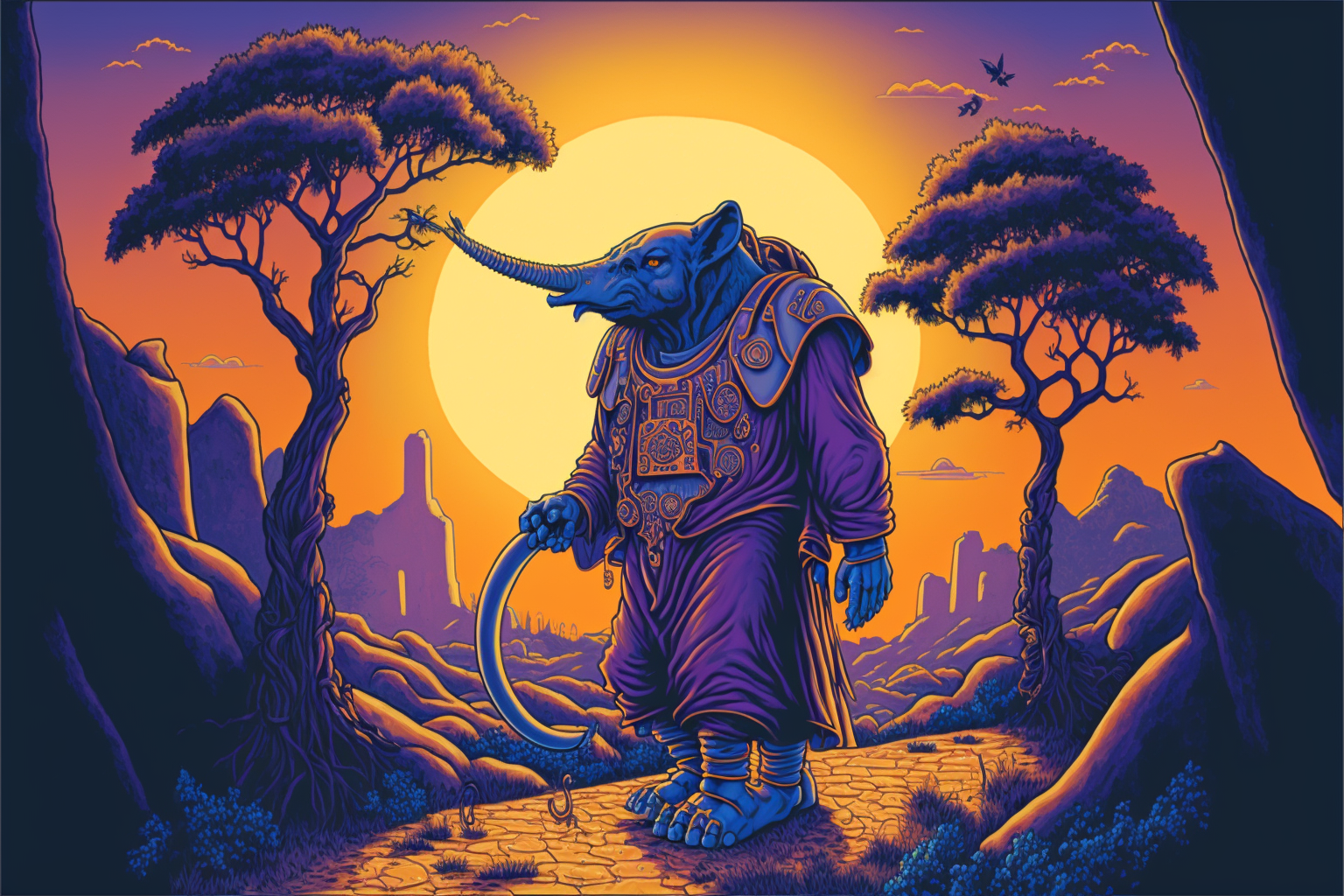Querequian Elders
The Querequian Elders were a long exinct species originating on the planet of Querequia to spinward of the Bubble. They are of historical importance as the first of the ruling species within the Querequian Cultures. The planet of Querequia was unique in being the home to two contemporaneous sophont species of roughly equal intelligence (the other being the Querequian Youngers)
Basic Information
Anatomy
Biological Traits
The males were on average slightly taller and heavier than the females. In the early years, some males were known to occasionally sport small facial tusks. This was always considered an oddity and over time, the trait, which was evidently recessive, ceased to be found.
Genetics and Reproduction
The tree of life on Querequia has favoured many variations on the theme of oviparous reproduction and the Elders belonged to this evolutionary branch. Fertilised eggs developed in the body of the mother over an internal gestation period of about three hundred (local) days and would then take a further sixty days on average before they hatched. In the prehistoric wandering days, after the eggs were laid, the mother and her mate and the remainder of the tribe would settle in the area round the nest to guard it until at least thirty days after hatching, when the young were capable of walking on their own. This enforced period without wandering meant that it was important to nest when and where there were abundant food sources for the tribe which would not be exhausted quickly. Later, as their civilisation advanced, farming and fortified settlements made the birthing period much safer.
Ecology and Habitats
The Querequian Elders evolved on the Trotephic plains on the continent of Zendoba on the planet Querequia, a "super earth" orbiting an orange giant star. The Trotephic plains are characterised by moderate rainfall and equitable temperatures and are home to a diverse variety of vegetation including scrub, open grassland and extensive open forests. The evolution of the Querequian Elders favoured individuals who could reach the widest variety of food. This led to the development of an upright gait with the trunk providing further reach into the treetops and the canopy ecosystem, not perhaps in an entirely dissimilar way to the forcing factors that developed the long necks of earthly giraffe, except that the Querequian Elders never became pure canopy feeding specialists, also using their hands to grub for roots and to plant crops.
Dietary Needs and Habits
The Querequian Elders were herbivorous but they were capable of digesting a wide variety of different kinds of vegetation. The bright lime green leaves of the golmarath tree was a staple part of their original diet, since this was a fast growing, successful and widespread wild species in their native range. They also favoured especially, the yellowish brown ykindia leaves and the soft, thick stalks of karameth grass. Fruits, nuts and roots of many other species were eaten both raw and also cooked in ways that allowed them to savour sources of nutrient that they would otherwise find difficult to consume. After their civilisation had mastered farming and genetic engineering, they spliced and diced genes not only from Querequia but from the many worlds where they travelled, considering themselves connaisseurs, supreme herbalists and gourmets.
Additional Information
Social Structure
The Querequian Elders were a pack species, tribal by nature and originally travelling in related family groups of no more than fifteen to twenty individuals when they were nomadic gatherers. Packs remained small in number so as to avoid depleating food resources locally. When youngsters reached the age where they were expected to find a mate, they would, both male and female, leave the pack on a solitary oddessy to find a new pack and to mix the genes of the species. If a pack grew too large it would split.
Periodically there would be meetings between packs for seasonal harvests where there was a local bounty of food and this would be an opportunity to exchange mates and knowledge. It was only as they developed farming and settled culture that the pack structure grew and customes changed. Nevertheless, Elders always identified with family, pack, species and Querequian Culture, in that order, even in the interstellar civilisation they built with the Querequian Youngers.
Geographic Origin and Distribution
Originally, in their pre-history, confined to the continent of Zendoba, the Elders had spread over the entire world of Querequia, long before they discovered the secrets of interstellar travel. At the height of the Querequian Cultures they were widespread throughout the Querequian Fall and there are records that they visited Earth. Most probably they travelled even beyond the limits of the zone controlled by their culture, and there are some records which suggest they may have occupied embassies coreward of the region now called the Jyncotax Halo, although the nature of any intelligences they were dealing with on those far flung outposts, remain somewhat mysterious.
Average Intelligence
The Elders were a highly intelligent species, driven in their evolution by several factors, including the need to find many and varied food sources to survive periodic outbreaks of disease in their favourite plant species, the need to avoid predation by the great clawed predator known as the Kyladon (a distant relative of the Querequian Youngers) and sexual selection pressure. They considered themselves superior in intellect to the Querequian Youngers, although this is certainly open to question.
Perception and Sensory Capabilities
Querequian Eldars had a very accute sense of hearing. The trunk, in addition to its delicate manipulative use, which worked well with the hands, was also a very fine instrument for olefactory use.
Civilization and Culture
Average Technological Level
By comparison with the technology currently available to the more advanced members of the Society Of Contemporary Races, it is widely believed that the Querequian Cultures had surpassed the capabilities of our age in several important areas but not in all. The Pthyle, for example, have gained (or regained from a study of the Cata-Zin) the ability to use Flicker Drive Zonal Restriction, something which was apparently not known to the Querequian Elders. However, at least in the later years of the Querequian Cultures, Querequian Flicker Drive speeds exceeded anything available to modern races. Their reputed skill in genetics and their understanding of alien biology of many kinds is also legendary.
History
The Querequian Elders, like an older twin, arrived on the scene just fractionally before the Querequian Youngers. Originally, they called themselves the Organa, which translated from one of their oldest languages, simply means, "the wanderers". By virtue of the fact that they "discovered" the Querequian Youngers in their own early exploration of Querequia rather than visa versa, they claimed the title of Elders and assigned the name of Youngers to their "discovery". These names were the ones that stuck for the rest of their existence as a species.
Historical Figures
Gritanomoss the Great is the most ancient of the universally known figures in the species history, credited with uniting the rival cities of Aloreth and Bandarill which led in short order to the unification of all the states on the continent of Zendoba and then the establishment of a single government of the Elders throughout Querequia within less than a hundred years.
Tharalde Morlaw made the treaty with the Querequian Youngers which is considered foundational for the Querequian Cultures, whilst Lirall Generex became the first of the Elders to leave the planet when she led an expedition to the moon Querelos.
After the discovery of interstellar travel and the first alien races, Krarib Breteyu established the Council of Citizens and a constitution which, though often amended, would survive for the remaining days of the Querequian Cultures.
Much later, Horob Netherim was the leader of the Council of Citizens responsible for negotiating with the Amnyine, when they first arrived in this dimension.
And later again, Tarak Madapal is known as the driving force behind the unfortunate project to tap the energy at the core of the planet which led to the infamous Mantle Convection Failure (more details of which can be found in the article about the planet of Querequia itself).
Interspecies Relations and Assumptions
The Querequian Elders always had a close relationship with the Querequian Youngers and this appears to have remained strong throughout the whole age of the Querequian Cultures, despite the many possibilities for strain that the management of the enormous interstellar civilisation must have presented over three million years. They saw themselves as mentors to a junior species and if that is not always exactly how the Youngers saw themselves, there is no doubt that the relationship was mutually beneficial. Later historians have argued that the connection they made on their home planet served as a template for the many contacts they would establish later in the wider galaxy. They were generally seen as benevolent, if sometimes a little too trusting but they were quick to learn and responsed to bad faith with a subtlety and intelligence that no other species in their sphere of influence could match so that they were seldom bested in the long run.
EXTINCT
Lifespan
80 years
Average Height
5 metres (male)
4.5 metres (female)
Average Weight
220 kg (male)
210 kg (female)
Average Length
0.8 metres
Geographic Distribution




Comments